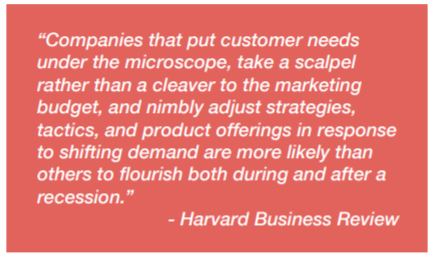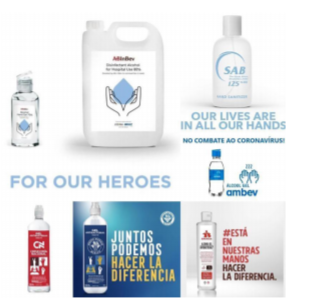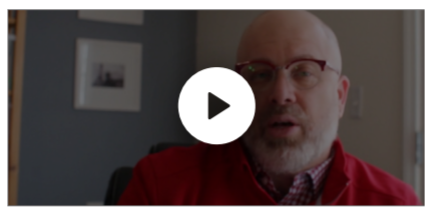A Message from our CEO
From The Desk of Adam Dorrell:
I wanted to take a moment and make a video for all of you. We know things are tough out there right now and it’s certainly not business as usual. A lot of you have reached out directly to us for guidance on how to run your Account Experience programs during the COVID-19 crisis. As a result, we decided to make this response kit to help you navigate the COVID-19 crisis so you can provide YOUR clients with the best possible experience in these uncertain times.
And let’s be clear with each other—retention, whether it be account or employee, matters now more than ever before. It was always important, but in this post-pandemic world, businesses across all industries are expecting slowed acquisition growth for the foreseeable future. It’s the right business decision to look inward to your customers and yes, even your employees for growth in 2020.
In closing, we know these are uncertain times, but we want you to be certain CustomerGauge will continue to be a reliable partner to you during this global pandemic. We’ll get through this and forge the new normal together. And the best thing you can do right now is focus on account and employee retention. We hope this response kit is helpful to you and your business. Please do not hesitate to reach out directly to me if you have any additional questions.

Why Retention Matters Now More Than Ever.
It’s time to get real—we’re in a global health crisis of the likes we’ve never experienced before in any of our lives. No matter what the experts say or predict, we don’t know what will happen.
These are times of great uncertainty and with uncertainty comes business instability, which can eventually lead to an economic downturn. Now, we’re not saying this to scare anyone—we’re saying this so we all understand the situation. If you attempt to understand something, you can start to fear it less.
And we’re confident, you have already positioned your companies in the best possible way to minimize the impact of whatever is coming our way. By investing in experience
and retention software, you already have the tools in place to help navigate through these murky waters.
This is a companion guide for you during the COVID-19 pandemic to help make both account and employee retention top priorities.

The important thing is to not panic. Just because we’re in a crisis, does not mean shifting strategies in a drastic way is the right thing to do. If you drift away from your current base now, you’ll be a weaker company as a result when we get out of this according to HBR.
The key is to find a sensible plan to maintain your account and employee retention rates. In other words, do everything possible to stabilize your brand in the minds of your internal employees and your external customers.
Account Retention
+ Why Should You Care?
+ What Should You Do?
+ How We Are Doing It
+ How Others Are Doing It
Why Should You Care?
As acquiring new business becomes more of a challenge, your existing account-base will become the major driver of growth for the foreseeable future.
We understand this is a sensitive time for all companies and surveying or collecting additional feedback from customers may not seem like the right thing to do, but we assure you, it’s the only thing to do!
Your customers are in front of their computers, now more than ever before. This is a fantastic opportunity to deepen the relationships you have with your accounts through sound outreach strategies and thoughtful, empathetic communication.
“your existing account-base will become the major driver of growth for the foreseeable future.”
What Should You Do?
5 Tips You Should Follow:
Lead With Empathy
Lead With Your People
Collect Feedback at The Same Levels, If Not More
Close The Loop Vigorously
Track Account Signals Other Than NPS
01 Lead With Empathy
First off, don’t act like it’s business as usual—it’s not. What worked yesterday, won’t necessarily work today. And more importantly, how you conduct business during this crisis will impact your brand’s perception after the crisis subsides. Our suggestion is to lead with empathy. If we can say it bluntly, don’t make it about you, make it about them. This means first, acknowledging the situation. It’s a shared experience across the entire world. For the first time in a long time, we all have something in common regardless of country or background. Use this to empathize with the person at the other end of the account. We are all people first, after all. Acknowledge the impact.
COVID-19 may have had on their business and people, but remind them, you are a partner they can count on during this time. Talk about how collecting feedback ‘under normal circumstances’ was important then, but again, acknowledge things have changed.
Mention that their feedback is relevant now, more than ever before, to ensure you’re meeting their needs in this difficult time. Not only that, demonstrate to them that you have taken steps to alleviate some of the burden COVID-19 has created in their business. Lift usage limits, open up features that are usually paid, etc.
If you can’t manage that, show them you’re doing your part by supporting causes that are on the front-line of the fight to stop the spread of COVID-19. Do anything you can to soften the blow and your accounts will remember your act of kindness for years to come.
“Mention that their feedback is relevant now, more than ever before, to ensure you’re meeting their needs in this difficult time.”
02 Lead With Your People
We suggest assigning an executive sponsor to every account (if possible). Their main goal is simple—just listen. Join the regular calls and listen to the account’s feedback, concerns and pains in their time of need. Then, activate these execs to be the champions for those accounts internally.
Empower them to work with the product or support teams to address concerns or push fixes that would greatly alleviate pain in the account. Next, make sure your CEO has skin in the game. If he/she hasn’t sent out a communication, consider doing this. Make your CEO’s message impactful by offering a plan to alleviate your customer’s pain in this time of uncertainty. If it’s not feasible based on the size of your company, tap him/her for a few customer calls a week. This simple act that will take 20min max a week will pay massive dividends not only for your accounts, but your CEO!
Another idea is to organize an organic outreach campaign at the support-level. Nothing fancy, no corporate scripts, simply “under normal circumstances, we’d conduct a review. But more importantly, how is everything going? I know things are
crazy right now, but is there anything I can help you with?” Oftentimes, customers will mention something that will make their lives easier. And what better time to offer a fix than now?
Focus on touching as many accounts as you can in a short amount of time to maximize the impact of the message. And finally, you can send a response kit (like this one) that details best practices companies can employ to better navigate uncertain times.
“Focus on touching as many accounts as you can in a short amount of time to maximize the impact of the message.”
03 Collect Feedback at The Same Levels, If Not More
So finally, let’s address what we’re sure is on a lot of people’s minds—are surveys really the right thing to send right now? Short answer is yes, if done properly. Again, lead with empathy (see above) and you should be fine.
Many of our customers are reporting NO drop-off in response rates post-pandemic vs pre-pandemic. This is an encouraging sign that companies are still taking customer feedback seriously. And here’s the thing—people are at their computers now more than ever before! We’d be surprised if response rates didn’t start to trend up!
Yes, we realize there can be this feeling that your accounts don’t want to hear from you or that they’re too busy to give feedback at the moment, but we’ll remind you that the companies who maintain strong account-bases during a crisis or down-turn will come out stronger on the other end. And let’s not forget, if you can help them in some way like offering free features or lifting usage caps, etc. We’re sure they’d love to hear from you.
So don’t be afraid to survey at normal rates or even above them with one caveat—make sure, now more than ever, you are closing the loop. If your organization is not currently capable of closing the loop on account feedback in this crisis, you could be doing your brand a disservice. The last thing you want one of your customers to think is, “they’re wasting my time and not taking my feedback seriously.” If you can’t effectively close the loop on the feedback received, scale back your sending to levels where you can close the loop. Start testing your infrastructure slowly and ramp up sending in tandem with your organization’s ability to close the loop with your accounts.
“Don’t be afraid to survey at normal rates or even above them with one
caveat—make sure, now more than ever, you are closing the loop.
04 Close the Loop Vigorously
If a major stakeholder from one of your accounts gives you detailed feedback and a passive or detractor score, don’t just ignore it. Now more than ever, follow-up on the feedback as quickly as possible.
Tie in the executive sponsor and reach out to let your customers know “we hear you and are doing everything humanly possible to address the issues.” And once you do address them, follow-up with an update and say “these are the actions we took as a result of your feedback.” Yes, it’s a lot of work, but people won’t forget your attention to detail and follow-up during this crisis.
Besides, increasing your Service Level Agreements (SLAs) for closing the loop will pay dividends in the long-run. People need to feel like they’re being heard. Sometimes, just being heard is the difference between keeping an account or losing it. If you can relay that you’ve heard them quicker, even better.
05 Track Account Signals Other Than NPS
If retention is your number 1 priority, surveying is important, yes. However, you can’t just rely on surveying to paint the full picture. You should also be monitoring account signals.
I know we talk about this a good amount, so we won’t give you the marketing version. But if you pair Net Promoter Score® (NPS) or satisfaction metrics with account asignals like product usage, support tickets, email engagement, etc., this can help your company monitor engagement from an entire account—across all stakeholders and channels. This most certainly will help you stay ahead of churn better than simply relying on a single survey point.
“You can’t just rely on surveying to paint the full picture. You should also be monitoring account signals.”
How We Are Doing It
• We’ve automated our relationship surveys in a staggered fashion to spread the close-the-loop support burden over a longer period of time.
• We’ve increased our internal SLA on customer calls from 4 weeks to 2 weeks.
• We’ve offered our customers free eNPS for 3 months so you can better monitor the health and wellness of your remote workforce as we enter into the new remote reality.
• We’ve assigned an executive sponsor to every one of our accounts.
• We’re upping our product email cadence. These will keep you informed of major updates that directly affect how you can retain your own clients whether it be through features or best practices.
• We’d like to start discussing issues like “managing an experience program during uncertain times” in a public forum via webinars. With our collective experience across a multitude of industries we can help bring clarity to a confused market so brands across the world could benefit in their time of need. More to come on this!
• Finally, we plan to over-deliver wherever possible. We’re taking this opportunity to streamline your experience with us. This may mean making things easier in the CustomerGauge app or on the business side. Please stay tuned for updates!
How Others Are Doing It
It’s not all bad news—companies around the globe are stepping up and putting their customers and communities’ needs first. In fact, while looking for examples to put into this response kit, we were overwhelmed.
Companies are delivering remarkable customer experiences in a big way during this crisis. We’ve decided to split the examples below into two different buckets—customer-centric and community-centric. Below, you’ll find great examples of both:
Customer-Centric Examples:
• Hootsuite is providing free access to its Professional Plan to nonprofits and small businesses impacted by the COVID-19 crisis.
• Internet providers like Comcast are boosting speeds on their basic packages and offering free internet to lowincome customers. Cox and Spectrum are also providing
limited-time internet to families with K-12 students.
• Google is allowing G Suite for Education customers to use the Hangouts Meet premium functionality for free through July 1.
• Zoom is free for schools and has lifted its 40-minute meeting limit.
• LinkedIn has a 16-part course on remote working it’s offering for free.
• Cisco is offering free 90-day licenses with unlimited usage.
• 1Password is offering its 1Password Business service free to small-business owners for six months
• Slack is offering free upgrades to teams actively working in response to COVID-19, including virus R&D, response plans and mitigation efforts.
• Mint Mobile is providing all current and new customers free unlimited high-speed data.
• T-Mobile is providing unlimited data to customers for the next 60 days in addition to data for mobile hotspot users.
• Banks such as Umpqua Bank, Wells Fargo and Bank of America are showing up to support their communities and, in particular, small businesses with offers ranging
from deferred credit card payments to specific grant programs.
• TaskRabbit now allows customers to cancel or reschedule a task within 24 hours of the start time if they fall ill.
• Adobe has made free our Creative Cloud desktop apps for students until May 31.
Community-Centric Examples:
• AB InBev (Anheuser-Busch) breweries are producing hand sanitizers and disinfectant to donate to hospitals and communities around the world.
• Tech companies like SoftBank, Apple, Facebook and Salesforce have donated significant supplies of N-95 masks to local hospitals. PG&E, Tesla, Flexport and IBM have also donated masks.
• Verizon is donating $2.5 million to nonprofit Local Initiatives Support Corporation for its Small Business COVID-19 Recovery Fund.
• Office 365 A1 is offering completely free and customized hub for class teamwork with Teams that includes video meetings, online versions of the Office 365 apps, as well as compliance tools, and information protection.
• Facebook is offering $100 million in cash grants and credits to up to 30,000 eligible small businesses in 20 countries.
• Lenovo has provided over $10 million in hardware & software to support hospitals and education across the globe.


Employee Retention
+ Why Should You Care?
+ What Should You Do?
+ How We Are Doing It
Why Should You Care?
Your employees are the heartbeat of your organization. And their commitment to the company has a direct impact on the sustainability of your business. However, recently, they’ve been asked to make more changes to their daily routines
than ever before.
Your employees are doing their best to adjust to this new remote reality while maintaining “business as usual”, but it’s a challenging time and they need your help. Now is the time to show your employees how much you care for their wellbeing
and will do what it takes to support them. Because a few months ago, there was a ‘war on talent’ and it will surely start up again after the COVID-19 pandemic is over.
“Your employees commitment to the compa ny has a direct impact on the sustainability of your business.”
We’ve said it before and we’ll say it again, happy employees yield happy customers. Keep your employees close during this time of wide-spread change and you’ll come out the other side with happy customers and a more cohesive team.?
What Should You Do?

4 Tips You Should Follow:
- Lead With Empathy
- Implement eNPS
- Be Transparent
- Implement Change
01 Again, Lead with Empathy
The single most important thing you can do for your employees right now is understand. “Empathy is a powerful tool that allows you to be open and understand
points of view that are vastly different from yours.”
Understand that everyone’s personal lives and work lives have just blended into one— and that means something different for each employee.
Some employees will adapt more easily, while others may need more regular check-ins, assistance, or active management.
No matter the unique circumstance, it is your responsibility, as an empathetic leader, to put yourself in another’s shoes and help them work through any challenges they may be facing.
Reach out to those employees who are living alone. Social interaction is a basic human need, but without it, some may struggle.
Let them know they have a support group that will be there for them whenever they need it. Establish ‘culture ambassadors’ from each department that have the
informal job to keep people connected through shared experiences in the remote world.
“Empathy is a powerful too
